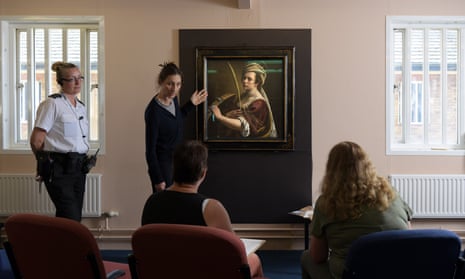When the National Gallery in London acquired a portrait by the great 17th-century artist Artemisia Gentileschi in 2018, the institution asked itself how this remarkable work, showing the painter in the guise of Saint Catherine of Alexandria, might help it fulfil its role as a truly national museum. The gallery has a long history of lending to other institutions. But once it was restored and ready to display, was there anything else it could do?
The answer was yes. The painting has been on a tour, unprecedented for a British museum, that has so far taken in a girls’ secondary school in Newcastle, a GP practice in East Yorkshire, a women’s prison in Surrey and the Glasgow Women’s Library. Its last stop, before returning to Trafalgar Square this summer, is a library in the London borough of Waltham Forest. The idea has been to bring the painting to people who would not, or could not, normally encounter it – taking art to the people rather than inviting the people to art.
Gentileschi’s own story is a powerful one. Born in Rome in 1593, she lost her mother at 12 and grew up learning painting from her father Orazio, who counted Caravaggio as part of his circle. In 1611, she was raped by an artist, Agostino Tassi, who had been hired to teach her perspective. During a six-month trial, Gentileschi endured public humiliation, and torture meant to ensure the honesty of her testimony. Tassi, who had raped multiple women and possibly attempted the murder of his wife, was convicted, but walked free soon after. Gentileschi married and moved to Florence. The National Gallery self-portrait was painted soon after that move. For later observers it has been hard not to read elements of her biography into it – her calm stare to the viewer imbued with quiet defiance, her hand resting on the instrument of her torture – the spiked wheel. Gentileschi went on to pursue a highly successful career as a painter, for a time at the English court. One of her finest self-portraits, which she brought with her to England from Italy, belongs to the Royal Collection – although that one has never graced a GP’s waiting room.
The National Gallery painting has provoked many conversations, particularly among women and girls, on its journey around England and Scotland. The girls at the Sacred Heart Catholic high school in Newcastle discovered a role model in her determination to follow her chosen career; the prisoners of Send found an ally in the painter with the steady gaze and were inspired to make their own artworks in response. Art’s role in promoting wellbeing and health was discussed when the picture went to East Yorkshire.
For a long time now, theatres, orchestras and other cultural organisations have been taking their work outside their own walls to people who might otherwise find it hard to reach. The National Gallery’s scheme follows in this tradition of committed, often unsung work in a bright and bold new way. Perhaps the most encouraging thing about the Gentileschi tour is that, in a funding climate that all too often privileges visitor numbers over the quality and depth of particular encounters with art, it has boldly asserted the importance of time, attention, thought and discussion. Artemisia Gentileschi, nearly four centuries after her death, may have changed lives these past weeks.
